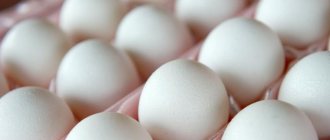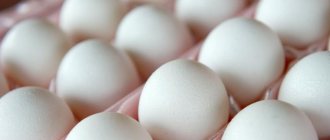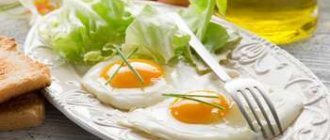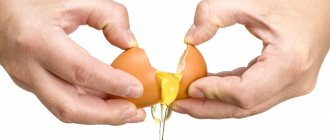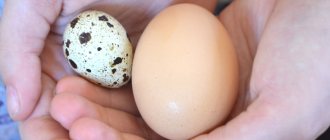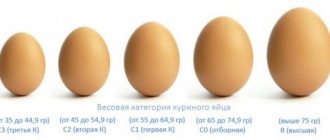Content
- How to choose the right eggs in a store by category?
- Why are some eggs difficult to peel?
- Iodine, selenium and vitamin A supplements in eggs – a marketing ploy?
- Why are quail eggs better than chicken eggs?
- What not to pay attention to when choosing eggs?
- Should you believe the “bio” and “eco” labels on egg packaging?
- What to look for when choosing eggs?
- How to determine the freshness of an egg if the expiration date is not indicated?
- How to store and cook eggs?
- How can you tell if an egg is raw or boiled?
How to choose the right eggs in a store by category?
According to current Russian standards, each egg produced at a poultry farm must have a marking that consists of letters and numbers - they can be blue or red.
Eggs are divided into categories depending on their mass. Information about belonging to any category is indicated on the shell in the form of numbers or letters. It is worth remembering a simple rule: the larger the number, the smaller the size will be. The largest eggs are indicated by letters.
- The smallest weigh from 35 to 44.9 g - 3rd category (3).
- Larger ones weigh from 45 to 54.9 g - 2nd category (2).
- Even larger - from 55 to 64.9 g - 1st category (1).
- Very large eggs - from 65 to 74.9 g - selected (O).
- The highest (B) category includes eggs weighing more than 75 g.
The larger the product, the tastier?
There is an opinion that large eggs are tastier than small ones, but there is no scientific evidence for this statement.
The letter “D” means that the egg is dietary
Such eggs are not stored at subzero temperatures and are sold within seven days. As a rule, in this case the marking is applied in red ink. There are practically no such eggs on the market.
They only have one week
A nuance: dietary eggs are not some special type of egg, they are the same table eggs. Their difference lies in freshness. Any dietary egg turns into a table egg seven days after production.
If you see that, judging by the date on the package, no more than a week has passed since sorting, then know that the egg is still dietary. even if there is no letter "D".
The letter "C" means that the egg is a table egg.
Some people think that the letter C means the product is fresh. This means that the egg is a table egg. Such eggs are sold within 25 days from the date of production. On their shell you will find blue markings. Table eggs can be stored for up to 25 days outside the refrigerator and up to 120 days in the refrigerator.
What is the difference?
If we talk about the differences, the first thing to mention is the size and weight. These indicators may be related to the breed and age of the chickens (young birds carry smaller specimens).
We recommend: Airplane mode on your phone – why do you need it if you’re not flying anywhere?
The second is cost. The average price for a dozen eggs of the first category is 68-90 rubles, depending on the manufacturer. A product labeled “C0” costs 87-110 rubles.
Advice! Pay attention to the packaging. Some manufacturers sell the product in containers of not 10, but 6 and 8 eggs.
For clarity, you can use the comparison table:
| CO | C1 |
| More expensive on average by 20-25% than C1 | More budget price |
| Larger in both size and weight | Lighter and finer CO |
| Nutritional value and chemical composition are the same | |
| Found on sale everywhere | |
| Shelf life: 90 days in the refrigerator and 25 days at room temperature | |
| Not recommended for consumption raw | |
Most manufacturers sell these particular categories of eggs, as they are most in demand.
Why are some eggs difficult to peel?
Have you noticed that you cook eggs for the same amount of time, at the same temperature, but some peel perfectly, while others are difficult? It's all about the freshness of the egg. The freshest, diet eggs have a very small air sac under the shell, which is why they are difficult to clean. Table eggs have time to absorb air through the pores of the shell, which greatly facilitates the process of cleaning them after cooking.
Blogger and food photographer Maria Kovaleva shares tips on how long to cook eggs, as well as how to cook eggs Benedict, cottage cheese omelet and shakshuka. Read HERE
.
Iodine, selenium and vitamin A supplements in eggs – a marketing ploy?
On store shelves you can find eggs with quite “bright” labels: “with iodine”, “country”, “with vitamin A and carotenoids”, “fitness” - eggs with selenium, “vitamin” eggs with a high content of fatty acids. Manufacturers call this enrichment “creating products with specified properties.” Such eggs are obtained by adding appropriate ingredients to the feed of laying hens.
Today, there is heated debate in society about these enrichment procedures. Some argue that this is certainly useful, because the egg with all its elements is absorbed by almost 97–98%. Others talk about marketing gimmicks and promote naturalness, arguing that nature has already put everything needed in the eggs.
For information
Nutritionists do not have a consensus on the benefits of egg fortification, since each person should have his own diet depending on the deficiency or excess of a particular element in the body.
Many manufacturers also label their products with the phrase “bright yolk.” In general, the color of the yolk depends on what the hen ate. Typically, the eggs of village chickens that grew in the wild have a rich yellow yolk color. In factory-farmed chickens fed a diet of mixed feed, the yolk color is light yellow. Therefore, some manufacturers began to introduce additives into the chicken diet that color the yolk bright orange.
Which ones are healthier?
For many, choosing eggs turns into a sacred sacrament. The color of the shell, the number and color of the yolks and other subtleties are taken into account. In general, there are many questions.
● White or brown? The color of the shell does not affect the usefulness of the eggs. However, brown eggs have stronger shells than white eggs. So if you have to carry a bag of eggs on a crowded train, it’s better to take brown ones.
● Dark yolk is healthier. This is also nothing more than a myth. The color of the yolk depends on the feed the chicken received. Experienced poultry farmers know that if you add more nettles to your chicken menu, the yolks will be darker. But this will not add any benefit to them.
● Eggs with two yolks are better. For those who love yolks - definitely. The older the chicken, the more likely it is for a double yolk to appear.
● If a boiled egg has voids between the white and the shell, it means the egg has been sitting for a long time . Absolute truth. The fresher the egg, the more “filling” it contains. By the way, determining the “date of birth” of an egg is very simple. Subtract 28 days from the expiration date and you will find out when the chicken laid this egg.
Why are quail eggs better than chicken eggs?
If you compare chicken eggs and quail eggs in terms of chemical composition, the difference is not immediately obvious. Moreover, quail eggs are not always the winner. In particular, per 100 g of protein product in chicken eggs there are 12.7 g, in quail eggs - 11.9; fat in chicken – 11.5 g, in quail – 13.1; carbohydrates in chicken - 0.7 g, in quail - 0.6. The energy value of quail eggs is slightly higher than chicken eggs: 168 kcal versus 157, but this also cannot be called a significant advantage.
In addition, quail eggs contain almost twice as much unwanted cholesterol as chicken eggs. What is their charm? It turns out that quail eggs are superior to chicken eggs in terms of the content of some minerals and vitamins. For example, quail eggs contain almost three times more magnesium and 28% more iron, and almost twice as much vitamin A.
Less benefit than it seems
Minerals from eggs are partially not absorbed by the body, and vitamins are mostly destroyed during heat treatment. This applies to both chicken and quail eggs.
It is believed that quails are exploited less aggressively because they are more demanding of their living conditions. They are not “pumped” with antibiotics and hormones; they are more carefully monitored for the cleanliness of the cells and the supply of fresh air. There is also a stricter attitude towards the quality of water and feed. Therefore, quail eggs are considered more environmentally friendly.
What is inside
Eggs are a source of large amounts of protein and calcium. Due to the content of almost all the vitamins necessary for the human body, such as vitamin A, B vitamins and vitamin D, as well as such essential elements as phosphorus, potassium, magnesium, zinc, iron, their regular consumption has a beneficial effect on work heart, strengthens and maintains bones, teeth, nervous system, vision and immunity.
Despite their not-too-low calorie content, eggs are a frequent guest on various diet menus. Their rich composition allows you to saturate yourself and get the necessary elements in a small amount of product. Eggs have a nutritional value of 157 kcal (per 100 g). And if you eat only proteins, then only 45 kcal, which is ideal for dietary dishes.
What not to pay attention to when choosing eggs?
- Egg color.
It confuses many, giving rise to fables. In reality, the color just depends on whether the chicken was “brunette” or “blonde”. Light breeds of chickens have white eggs, while black, variegated and red ones have brown egg shells. The composition of white and brown eggs is identical, the nutritional properties do not differ. - Roughness of the shell.
There is an opinion that a rough shell is a sign of a low-quality product, which is not rich in vitamins and has a more fragile structure, that is, such a product is easy to break. Laboratory studies by Roskachestvo did not reveal any relationship between shell texture and egg quality. - The inscriptions “bio” and “eco” on the packaging of eggs.
Considering that there is no certification on this issue in Russia, they cannot guarantee anything. Abroad, this may mean that laying hens were raised on free range and natural feed rich in chlorophyll.
What does the law say?
After the Federal Law “On Organic Products and on Amendments to Certain Legislative Acts of the Russian Federation” comes into force, confirmation of the conformity of organic products is carried out in the form of voluntary certification carried out by certification bodies accredited by Rosaccreditation. From January 1, 2021, domestic products labeled as organic and having foreign certificates or certificates from non-accredited certification bodies cannot put “organic” names in Russian on the packaging, nor use the National Mark.
At the same time, placing “organic” inscriptions in a foreign language (Bio, Organic, Eco, etc.) on the packaging of goods is not prohibited by law (the placement of the designations “Bio” and “Eco” written in Cyrillic is not yet regulated).
Details HERE
.
Eggs in proper nutrition
The principles of a healthy lifestyle and, in particular, proper nutrition are becoming increasingly popular among the population. This allows you to have an attractive appearance, improve your health, and improve your overall psychological well-being. But sometimes, adhering to the norms of rational nutrition, we have to refuse or greatly limit some of our usual food products. Could there be eggs among them? Let's try to answer this question?
Are eggs necessary in food?
Eggs have appeared in the human diet since time immemorial and are included in all (or almost all) dishes of the peoples of the world. In fact, it is a very valuable food product. What makes it so is that the egg must contain all the substances necessary for the formation of a new multicellular organism. If you look at the percentage of nutrients in a chicken egg, we get:
- proteins – 12.57%;
- fats – 12.02%;
- carbohydrates – 0.67%;
- minerals – 1.07%;
- water – 7.67%.
Moreover, all components are relatively easily digestible (depending on the method and degree of cooking).
The vitamin composition of eggs has the following indicators:
- vitamin A - 0.45 mg;
- B6 – 0.14;
- B12 – 2.0;
- E – 1.2;
- D – 2.0;
- Folacin – 17.0;
- Riboflavin – 0.44;
- Niacin – 0.39;
- Thiamine – 0.07;
- Pantothenic acid – 1.2;
- Choline – 320;
- Biotin – 20.7 mcg.
In addition, they contain minerals such as phosphorus, calcium, magnesium, chlorine, potassium, sulfur, iron, sodium. Thanks to this composition, the egg is considered a dietary and complete food product.
How many eggs can you eat on a diet?
Before answering this question, you need to remember that an egg consists of two components - the yolk and the white. These are two very different substances. The white contains mainly proteins, and the yolk contains lipids. It is this feature that underlies the principles of using eggs in dietary nutrition. Since weight loss is only possible if the amount of energy consumed is reduced compared to energy consumed, fats are the first to be corrected. In an egg they are contained in the yolk, so the number of yolks should be limited to one. But proteins can be consumed in any quantity within the ratio of proteins, fats and carbohydrates. Protein omelettes are a frequent guest on the table of people who adhere to proper nutrition. They are well absorbed and do not carry a large energy load. Egg white proteins are ideal for low-calorie dieters - they contain four times fewer calories than beef and six times fewer calories than pork. You should not completely give up the yolk, since it contains the so-called “good” cholesterol, which is absorbed by the body and does not leave fatty plaques in the bloodstream. In addition, almost all vitamins are also concentrated in the yolk. Therefore, eggs must be present in the diet of people who control their weight, but yolks should be limited to one. Recently, more and more adherents of a healthy diet are talking about quail eggs as healthier.
Are quail eggs healthier than chicken eggs?
In order not to write an ode to quail eggs, it is enough to simply compare their composition with chicken eggs. They contain 2-3 times more vitamins A, group B and rutin (vitamin P). In addition, they also have an advantage in iron, magnesium and potassium content. But unlike chicken eggs obtained from poultry farms with a high level of quality control and sanitary standards, quail eggs are sold by individual farmers from private yards, often without the appropriate documents. Therefore, the risk of contracting salmonellosis when consuming a homemade product increases several times. If the choice is made specifically on a quail product, then it is worth asking the seller for documents confirming the bacteriological safety of the product.
What can you cook from eggs?
It is known that a varied diet allows you not only to nourish the body, but also to bring pleasure from eating. Eating only boiled eggs every day will quickly get boring, so it’s worth diversifying your menu with simple but unusual dishes made from them:
- Scramble is an American version of scrambled eggs. The secret and difference is that the loose eggs mix during the frying process all the time and form a kind of large flakes. You can add various components to them: vegetables, mushrooms, boiled meat;
- eggs in onions, peppers or tomatoes - a regular fried egg, poured into rings of anything that can be combined with an egg and act as a rim;
- protein omelet - beat three whites and one yolk with water or milk and pour into a hot frying pan or cook in a water bath. The main thing is not to forget to add a little salt.
Thanks to these simple recipes, you can include eggs in your diet every day in a new, unusual taste.
What to look for when choosing eggs?
- Production time.
Must be indicated on the packaging. The fresher the egg, the better it is, of course. - Manufacturer.
Whoever is closer in geographical location to the outlet is better. The less the egg bounces along the roads, getting from the farm to the counter, the better. - Shell.
Examine it for cracks, chips and cleanliness. It is desirable that the eggs are clean, without feathers or traces of droppings, and without damage. - Place for storing eggs.
It must be dry, clean and must be free of foreign odors. Eggs are like a sponge, absorbing unwanted odors. This also applies to the packaging: there should be no mold or stains on it. - Shelf life of eggs.
It is regulated by GOST R 52121-2003 “Chicken eggs for food. Technical conditions".
Storage at temperatures from 0 to 20 °C and relative air humidity of 85–88% is provided for:
- dietary eggs – no more than 7 days;
- table eggs – from 8 to 25 days;
- washed eggs - no more than 12 days.
How to store and cook eggs?
- Keep eggs away from strong-smelling foods and raw meats. The best temperature is approximately 0–5 °C.
- Before use, wash eggs with soap and warm running water.
Wash your hands
Important! Wash your hands, even if you just touched the egg. Remember, the causative agent of a serious infectious disease, the salmonella bacterium, can live on eggshells.
- Boil eggs in salted water. Even if the egg cracks, the salt will prevent the white from leaking out.
- After the eggs have reached the desired condition during cooking, dip them in ice water, this will help them clean better.
